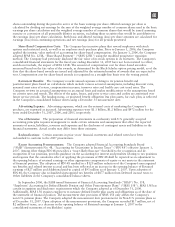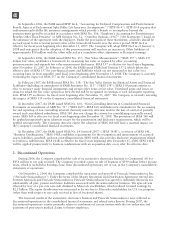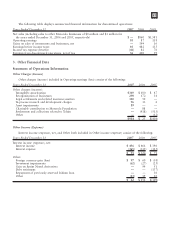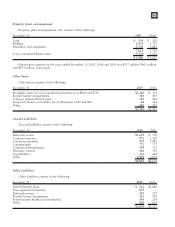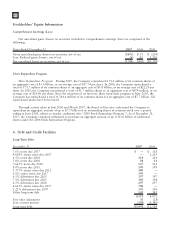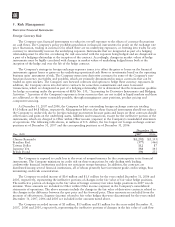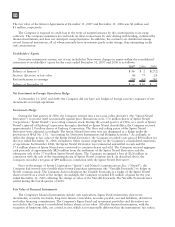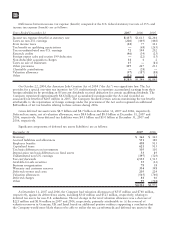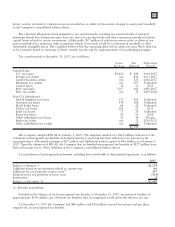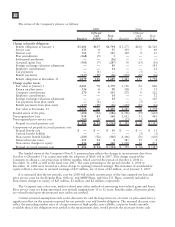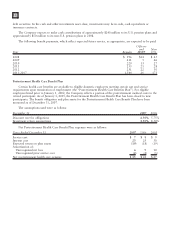Motorola 2007 Annual Report Download - page 101
Download and view the complete annual report
Please find page 101 of the 2007 Motorola annual report below. You can navigate through the pages in the report by either clicking on the pages listed below, or by using the keyword search tool below to find specific information within the annual report.
hedge positions. These amounts are included in Other within Other income (expense) in the Company’s
consolidated statements of operations. The above amounts include the change in the fair value of derivative
contracts related to the changes in the difference between the spot price and the forward price. These amounts are
excluded from the measure of effectiveness. Expense (income) related to cash flow hedges that were discontinued
for the years ended December 31, 2007, 2006 and 2005 are included in the amounts noted above.
During the years ended December 31, 2007, 2006 and 2005, on a pre-tax basis, income (expense) of
$(16) million, $(98) million and $21 million, respectively, was reclassified from equity to earnings in the
Company’s consolidated statements of operations.
At December 31, 2007, the maximum term of derivative instruments that hedge forecasted transactions was
one year. However, the weighted average duration of the Company’s derivative instruments that hedge forecasted
transactions was five months.
Interest Rate Risk
At December 31, 2007, the Company’s short-term debt consisted primarily of $134 million of short-term
foreign debt, priced at short-term interest rates. The Company has $4.2 billion of long-term debt, including the
current portion of long-term debt, which is primarily priced at long-term, fixed interest rates.
In order to manage the mix of fixed and floating rates in its debt portfolio, the Company has entered into
interest rate swaps to change the characteristics of interest rate payments from fixed-rate payments to short-term
LIBOR-based variable rate payments. The following table displays these outstanding interest rate swaps at
December 31, 2007:
Date Executed
Notional Amount
Hedged
(In Millions) Underlying Debt Instrument
October 2007 $ 400 5.375% notes due 2012
October 2007 400 6.0% notes due 2017
September 2003 457 7.625% debentures due 2010
September 2003 600 8.0% notes due 2011
May 2003 114 6.5% notes due 2008
May 2003 84 5.8% debentures due 2008
May 2003 69 7.625% debentures due 2010
$2,124
The weighted average short-term LIBOR-based variable rate payments on each of the above interest rate
swaps was 6.60% for the three months ended December 31, 2007. The fair value of the above interest rate swaps
at December 31, 2007 and December 31, 2006, was $36 million and $(47) million, respectively. Except as noted
below, the Company had no outstanding commodity derivatives, currency swaps or options relating to debt
instruments at December 31, 2007 or December 31, 2006.
The Company designated the above interest rate swap agreements as part of fair value hedging relationships.
As such, changes in the fair value of the hedging instrument, as well as the hedged debt are recognized in earnings,
therefore adjusting the carrying amount of the debt. Interest expense on the debt is adjusted to include the
payments made or received under such hedge agreements. In 2007, the Company recorded an expense of
$2.3 million representing the ineffective portions of changes in the fair value of interest rate swap hedge positions.
These amounts are included in Other within Other income (expense) in the Company’s consolidated statements of
operations. In the event the underlying debt instrument matures or is redeemed or repurchased, the Company is
likely to terminate the corresponding interest rate swap contracts.
Additionally, one of the Company’s European subsidiaries has outstanding interest rate agreements (“Interest
Agreements”) relating to a Euro-denominated loan. The interest on the Euro-denominated loan is floating based on
3-month EURIBOR plus a spread. The Interest Agreements change the characteristics of interest rate payments
from short-term EURIBOR based variable payments to maximum fixed-rate payments. The Interest Agreements
are not accounted for as a part of a hedging relationship and accordingly the changes in the fair value of the
Interest Agreements are included in Other income (expense) in the Company’s consolidated statements of
operations. The weighted average fixed rate payments on these EURIBOR interest rate agreements was 6.71%.
93


